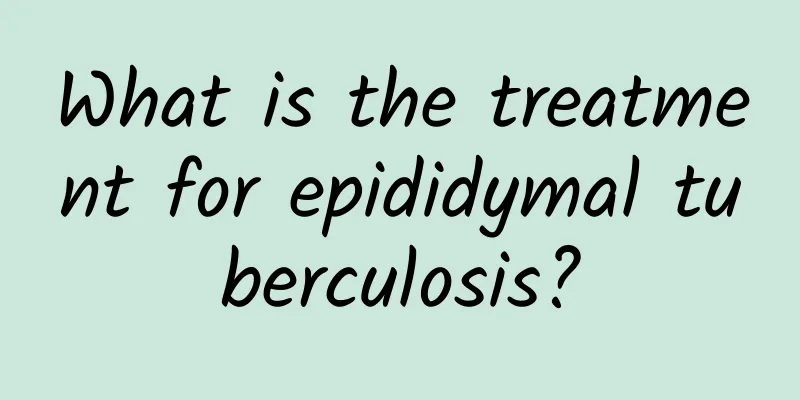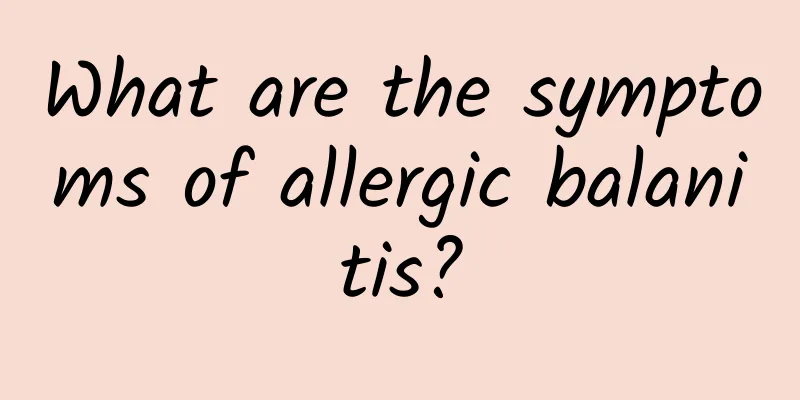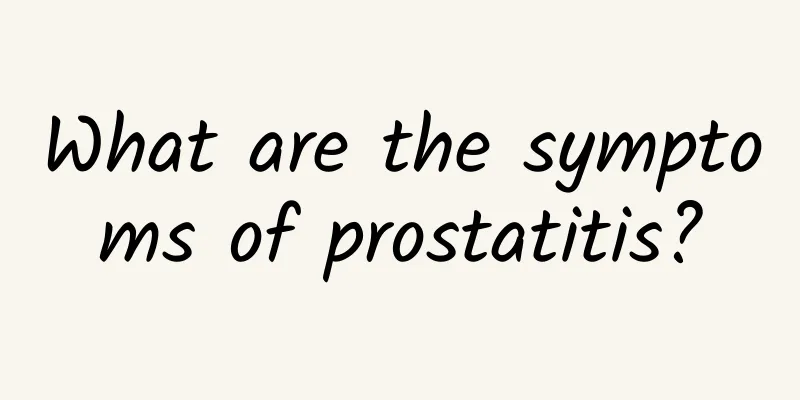What is the treatment for epididymal tuberculosis?

|
Epididymal tuberculosis is a common type of male genital tuberculosis. The disease is also called tuberculous epididymitis. The disease progresses slowly. There is no pain or other discomfort at the beginning. Only when it develops to a certain stage will the patient experience pain and easily develop a high fever. The scrotum will swell. At this time, timely treatment is necessary. Common treatment methods are as follows. 1. Treatment principles 1.1 During treatment, you should pay attention to rest, nutrition, and avoid fatigue. 2. Drug treatment 2.1 Isoniazid: It has an inhibitory and killing effect on tuberculosis bacteria and can eliminate tuberculosis bacteria that grow vigorously inside and outside cells. However, its bactericidal effect on bacteria with very slow metabolism and intermittent reproduction is not as good as rifampicin, and it is not as effective as pyrazinamide on tuberculosis bacteria in the acidic environment of macrophages. It is well absorbed orally, has low toxicity, and can be taken for a long time. Isoniazid molecules are small and widely distributed in the body. The concentration in tissues is consistent with that in plasma. The drug concentration in various tissues, including caseous lesions and macrophages, is higher than the concentration required to kill bacteria. Isoniazid is metabolized in the liver, and its metabolic pathway can be through ethylation and decomposition by the P450 oxidase system in the liver. The main toxic reactions are peripheral neuritis and hepatitis. The onset of neuritis is related to the drug dosage. Long-term use of isoniazid can increase serum transaminase. Liver function should be checked regularly. If the transaminase exceeds 5 times the normal level, the drug should be discontinued. It can be restored after discontinuation of the drug. Isoniazid can cause mental excitement, abnormal sensation, and optic atrophy. 2.2 Pyrazinamide: It has a bactericidal effect on human tuberculosis. The division and metabolism of tuberculosis bacteria in macrophages are slow, and they are in a latent state. The pH value in macrophages is low, which affects the bactericidal effect of anti-tuberculosis drugs. Bacteria are not easily killed by other anti-tuberculosis drugs. It is the root cause of tuberculosis relapse. Pyrazinamide has a special killing effect on tuberculosis bacteria in the acidic environment of macrophages. Bovine tuberculosis is resistant to it. Pyrazinamide is excreted in the urine with a half-life of 9 hours. If the daily dose is less than 2g, it is combined with isoflurane and rifampicin, and the hepatotoxicity is not significant. If the daily dose exceeds 3g, the hepatotoxicity will increase significantly. The metabolites of pyrazinamide can compete with uric acid and inhibit the excretion of uric acid, thus increasing the uric acid in the body and causing joint pain. 2.3 Streptomycin: It has a bactericidal effect on tuberculosis bacteria and can hinder the synthesis of cell proteins. After intramuscular injection, it quickly enters the tissue and can enter the tuberculosis cavity and caseous tissue, but it cannot enter the cells. It can only kill tuberculosis bacteria outside the cells. Streptomycin is excreted from the urine through glomerular filtration. When the kidney function is poor, cumulative poisoning is prone to occur. The main toxic reaction is the impact on the eighth pair of cranial nerves. If dizziness occurs, it can be recovered if the drug is stopped in time, but deafness is often permanent, so it should be closely observed during use. The toxicity of streptomycin varies greatly from person to person. Some patients may experience it within a few days of injection. Therefore, if tinnitus and abnormal sensations and blockages in the ears occur after injection, the drug should be stopped immediately. This drug can cause allergic reactions, so an allergy skin test should be done before use. 3. Surgical treatment Early epididymal tuberculosis can be cured by drug treatment. If local leprosy-like necrosis is severe, involving the testicles, the lesions are large and abscesses are formed, or the drug treatment effect is not obvious, epididymis removal can be performed. If the testicles have lesions and the lesions are close to the epididymis, the testicles can be partially removed together with the epididymis. The testicles should be preserved as much as possible during the operation. After epididymis removal, seminal vesicle and prostate tuberculosis can usually heal gradually. 4. External treatment of epididymal tuberculosis Apply Chonghe paste (stir-fried Bauhinia bark 150g, Angelica dahurica 90g, Red Peony Root 60g, Angelica dahurica 20g, Acorus tatarinowii 45g. Grind into fine powder, mix with scallion juice and aged wine) to the affected part. For fistula formation, insert red dan medicine thread to remove pus and rot. For those with continuous pus exudation from the sinus, pay attention to cleaning and change the dressing frequently. 5. Western medicine treatment 5.1 Western medicine mainly treats epididymal tuberculosis through two approaches: anti-tumor drugs and surgery. Anti-tumor drugs should be used in combination. The drugs and dosages are as follows: Streptococcus: 1 gram intramuscularly daily for 2 weeks, then 1 gram twice a week. Isoniazid: 0.1 g each time, orally 3 times a day. Sodium para-aminosalicylate: 8-12 grams per day, taken orally in 3 divided doses. The above drugs should be used in sufficient doses without interruption, generally for 3 to 6 months, and then the treatment effect can be estimated based on symptoms and signs, as well as semen and prostatic fluid tests. If the above drugs are ineffective, you can consider using drugs such as thiosemicarbazide, cycloserine, ethionamide, pyrazinamide, kanamycin, etc. During drug treatment, you should pay attention to rest, strengthen nutrition, and supplement vitamins. 5.2 When the epididymal tuberculosis nodules are large, with a diameter of more than 0.5 to 1 cm, and the lesions are extensive, even forming tuberculous abscesses or involving the scrotal wall to form sinuses, and anti-tumor treatment is ineffective, it means that the epididymal tuberculosis is already terminal and the epididymis has lost its function. Keeping it is not only redundant, but may be harmful to health, so it is better to remove it surgically. If the testicles are not affected, they must be retained. 5.3 There is no doubt that bilateral epididymisectomy will result in loss of fertility. Although some doctors try vasectomy, the success rate of the operation is very low, so the chance of restoring fertility after the operation is also very small. |
<<: What should men eat to replenish sperm? These foods are the first choice!
>>: How should a testicular laceration be treated?
Recommend
With this complete kidney-tonifying recipe, you no longer have to worry about frequent and urgent urination.
There are many ways for men to nourish their kidn...
Men don’t need to worry if clear liquid leaks from the penis!
When a man's penis is stimulated to a certain...
Pictures of symptoms of penile infection and beriberi
Bacterial infection of the glans penis is common ...
How can men increase their sexual ability?
The decline of male sexual ability is related to ...
What should men who are preparing to conceive pay attention to?
During the pregnancy preparation period, both hus...
How to treat chronic prostatitis?
Chronic prostatitis is a disease that troubles ma...
What is the normal body temperature for men?
The temperature inside the human body is called b...
How to detect genital herpes
Patients with genital herpes must pay attention t...
What are the symptoms of premature ejaculation?
There are many common diseases among men. Drugs a...
What does it mean when a small bubble grows on the glans?
It can be said that the glans of men is a very se...
Small red spot bleeding on the glans
When men accidentally notice a red spot on their ...
What should middle-aged men do about hair loss?
Middle-aged men are under great pressure, with el...
What's wrong with semen in urine?
Recently, I felt something different when I searc...
What to do if your skin becomes red? How to deal with red skin
I don't know if you have ever had this experi...
There is a tendency towards premature ejaculation
Premature ejaculation is the most common erectile...









